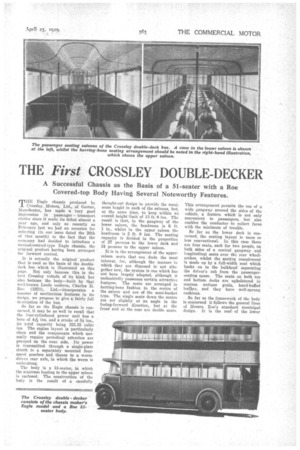THE First CROSSLEY DOUBLE-DECKER
Page 53

Page 54

If you've noticed an error in this article please click here to report it so we can fix it.
A Successful Chassis as the Basis of a 51-seater with a Roe Covered-top Body Having Several Noteworthy Features.
rilHE Eagle chassis produced by Crossley„ Motors,. Ltd., of Gorton, Manchester, has made a very good impression in passenger transport circles since it made its debut almost a year ago, and only as recently as February last we had an occasion for referring (in our issue dated the 26th of that month) to the fact that the company had decided to introduce a nointal-control-type Eagle chassis, the original product having been arranged for forward control.
It is actually the original product that is used as the basis of the doubledeck bus which is illustrated on this page. Not only because this is the trst Crossley vehicle of its kind, but also because the body—built by that well-known Leeds con"cern, Charles II. hoe (1923), Ltd.—incorporates a number of meritorious features in its design, we propose to give a fairly full ascription of the bus.
So far as the Eagle chassis is concerned, it may be as well to recall that the four-cylindcred power unit has a bore of 4-1§6ins, and a stroke of 51 ins., its total capacity being 321.35 cubic ins, The engine layout is particularly clean and the components which normally require periodical attention are grouped on the near side. Its power is transmitted through a single-plate clutch to a separately mounted fourspeed gearbox and thence to a wormdriven rear axle, in which the worm is onderslung.
The body is a 51-seater, in which the staircase leading to the upper saloon is enclosed. The construction of the body is the result of a carefully thought-out design to provide the maximum height in each of the saloons, but, at the same time, to keep within an overall height limit of 13 ft. 6 ins. The result is that, in the gangway of the lower saloon, the headroom is 6 ft. 1 in., whilst in the upper saloon the headroom is 5 ft. 9 ins. The seating capacity is divided in the proportion of 27 persons to the lower deck and 24 persons to the upper saloon.
It is in the arrangement of the tippersaloon seats that one finds the most interest. for, although the manner in which they are disposed is not altogether new, the system is one which has not been largely adopted, although it undoubtedly possesses certain attractive features. The seats are arranged in herring-bone fashion in the centre of the saloon and are of the semi-bucket type. The single seats down the centre are set slightly at an angle in the facing-forward direction, but at the front and at the rear are double scats.
This arrangement permits the use of a wide gangway around the sides of the vehicle, a feature which is not only convenient to passengers, but also enables the conductor to collect fares with the minimum of trouble.
So far as the lower deck is concorned, the seating layout is more or less conventional, in this case there are four seats, each for two people, on both sides of a central gangway and longitudinal seats over the rear wheelarches, whilst the seating complement is made up by a full-width seat which backs on to the bulkhead separating the driver's cab from the passengerseating space. The seats on both top and bottom decks are upholstered in maroon antique grain, hand-buffed leather, and they have well-sprung cushions.
So far as the framework of the body is concerned it follows the general lines of Messrs. floe's standard municipal design. It is the roof of the lower deck that calls for special notice, because it enables unusual headroom to be given in the gangway. The cambered sides, which really form wells and constitute the gangways in the upper saloon, ensure ample room for passengers in the lower saloon to move freely when they are reaching or leaving the seats.
The of ceilings of both decks are panelled in aluminium, the sheets being covered at the joints by suitable mouldings. The combination of the french-polished English-walnut mouldings and the window fillets give a very pleasing effect Three of the windows in the top deck are of the Beclawat sliding type, but those in the lower saloon are all of the fixed type, although they do not reach to the top of the light, the openings being protected by glass louvres, thus ensuring that ample ventilation is secured without the ' possibility of draught being set up.
Doverite-covered stanchions, stair
case rails and amending handles, as well as chromium-plated fittings and bell-shaped globes for the electric lights, all lend their quota to an attractive body which appears to be suitable for either private or municipal service.
In conclusion it can be mentioned that the laden weight of the vehicle with a full complement of passengers, as well as the driver and conductor, is within the 9-ton limit set by the Ministry of Transport for four-wheeled, double-deck buses.














































































































